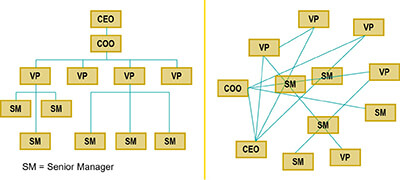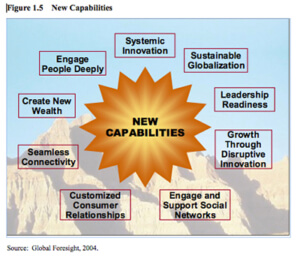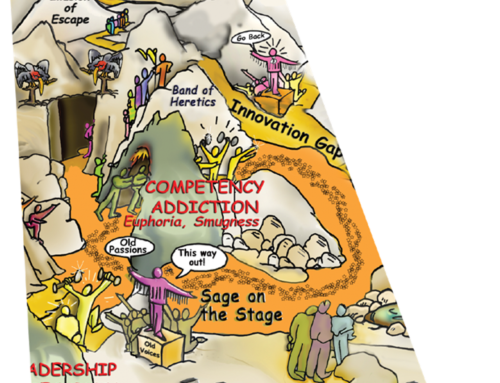Organizational readiness for the decade ahead will come from facing and dealing with the challenges in the landscape and then resolving any organizational pains, like competency addiction, as they arise. Tough times compel organizations to make choices and trade-offs to resolve those pains so they can progress.
An all too common impediment to innovation is informal networks devoted to the status quo. These social networks need to be transformed into strategic power networks toward the ultimate goal: creation of a new capability, “Systemic Innovation” – but first you need to be well on your way to extinguishing competency addictions. Think of the company Netflix, which triumphed through its ability transform old competencies. It began renting DVDs by mail, moved into online streaming as that technology emerged, and ultimately made the company a global force by creating its own content rather than relying exclusively on that produced by others. 15 Oscar nominations and three awards in 2019 are testimony to the virtues of resolving competency addiction.
Here are 6 steps to do just that:
1. Confront Your Competency Addictions, Seek Out Heretics
Start out by internally scanning and scouting for competency addiction. Apply the principle “Act with Integrity” to determine the role such addictions are likely to play as an obstacle to a successful journey from the Badlands by blocking innovation.
At the same time, assess the vitality and resiliency of your organization, key indicators of organizational readiness. To make these assessments, you need to listen to outside voices as well as your own instincts and research.
Another key indicator of organizational readiness is the number, visibility, and influence of heretics on the inside. With any luck, you still have a few; many leave companies that appear to them to have little capacity for future innovation.
Heretics are extremely helpful because they are keen observers of the organization. They know the organization’s competitive weaknesses and where its big obstacles to progress are. They spend most of their time on the fringes of the organizations, making forays into the heart of the beast and scanning the external environment.
A key lesson from the history of cycles of innovation is that change usually comes from the fringe, not the center. All too often, top leaders have lost any connection with their organization’s heretics and innovators. These people tend to be perceived as troublemakers. Effective leadership means spending time with people who make you uncomfortable.
2. Map the Structure of the Social Networks to See What Holds Competency Addictions in Place
 Most organizations and their leaders focus on the traditional hierarchical organization chart, although everyone knows that key people are interconnected in informal networks of influence that are invisible to most people. Leaders need to understand the human forces that keep competency addiction in place before they can extinguish it.
Most organizations and their leaders focus on the traditional hierarchical organization chart, although everyone knows that key people are interconnected in informal networks of influence that are invisible to most people. Leaders need to understand the human forces that keep competency addiction in place before they can extinguish it.
Social networks either enable or prevent innovation. It’s the people in key roles who hold competency addictions in place. They control the flow of information and resources, directing them through their networks into fading core competencies. Over time they have structured their personal networks in ways that make it easy to divert resources away from new ideas that threaten their positions.
Leaders need to pierce informal networks and connect with their leaders as well as the heretics and innovators connected in them. Making these positions and interconnections visible reveals how these relationships work to reinforce competency addiction. This allows top leadership to put strategies in place that will systematically interrupt any flow of resources that is not beneficial to the organization’s future.
Left alone, these networks, which are not aligned with the direction in which the organization needs to go, remain formidable barriers to progress. They must be replaced with strategic power networks that support innovation.
3. Analyze the Intersection of Global Drivers and Your Competency Addiction
During this assessment you can identify the power of your organization’s competency addiction to impede progress. This will help you choose which issues to focus on quickly and which ones you can safely ignore.
Identify the specific drivers and trends that will shape your business landscape over the next five years. Systematically and thoroughly detail the exact impacts they are having, or will have, on your company and market. Consider the opportunities they will create. Analyze how your competency addictions will impede a competitive response to these drivers, and what innovations you will need to address them.
4. Imagine What New Competences and Capabilities You Might Need for The Future
 Rich strategic dialogue and many small experiments uncover needed need new competencies.
Rich strategic dialogue and many small experiments uncover needed need new competencies.
Most successful companies are organized as silos of specialization performing tried-and-true routines that have led to success; what innovation they indulge in is incremental and tied to their core competencies.
My research shows that despite the Great Recession, and the subsequently uneven and in places anemic economic growth, many companies are still relying on old competencies that are mismatched to the issues and needs of the recovery and beyond.
To further complicate things, most companies think not in terms of competencies but in terms of organizational structures, products, services, and roles. Few organizations have made the switch to thinking of themselves as a portfolio of competencies, capabilities, and people networks. Few have systematically thought about these competencies, how they support what they produce, and the way the company does business.
5. Define Your Innovation Gap
Competency addiction can’t easily take hold or stay rooted within a climate of Systemic Innovation.
Once you have achieved a deeper understanding of your competencies and addictions, your next step is to determine your innovation gap – the difference between the speed with which innovation occurs in the marketplace and your organization’s ability to create innovation and respond to marketplace demands.
The rhetoric of innovation, so ubiquitous leading up to the Badlands, often failed to yield sufficient results: Words substituted for action, helping the company fall into the knowing-doing gap. The unintended consequence of this flow of words in place of action was the residue of cynicism and resistance to innovation that it left in many organizations, which makes the innovation gap much harder to close today.
In many ways, innovation is treated as a diversion form the real work of ensuring profits from current business lines.
My recent research on innovation indicates a persistent innovation gap. Most (75 percent) of the companies I studied reported that they were functioning in a highly unstable environment in which markets, competitors, new technologies, and consumer preferences could change rapidly and unpredictably. Yet only 30 percent reported that they had put effective innovation processes in place.
Most reported they still adopt innovation cautiously, and then only after its benefits are crystal-clear. Most still invest resources to support incremental innovation in core businesses and remain shy of more radical ideas.
6. Creating Self Generating Eco-Webs
A second barrier to closing the innovation gap is the fact that many organizations don’t actually know what an innovative organization looks and feels like. Nor have they thought through which specific challenges they wish to address through innovation.
Each organizational structure, from hierarchical to fishnets, has its own strengths and weaknesses when it comes to innovation and adapting to this innovation imperative. No one type of organization will thrive, but all of them need to create “self-generating eco-webs.”
Self-generating eco-webs consist of people (within organizations or business units) who mobilize quickly to take advantage of an early business opportunity or to pursue an innovative idea that they are very passionate about. Eco-webs can be spun within any organizational type that has a sufficient systemic innovation capacity to include shared leadership.
The webs thrive as long as conditions are right and break up when the opportunity has been realized. These Velcro relationships, where you attach strongly and break apart with no damage when the work is done, are critical to success.
Parting Thoughts…
Address and resolve Competency Addiction and create Systemic Innovation simultaneously as one major thrust and shift. Inoculate your organization with an epidemic of innovation. This takes courage and learning a whole lot about social movements and epidemics, not knowledge resident in most companies. It is easy to deny you have competency addiction but there is only the illusion of escape from having to confront them.
Want to learn more? Read Competency Addiction – Don’t Get Lost in Familiar Territory
Download the complete Competency Addiction Article as a PDF.


